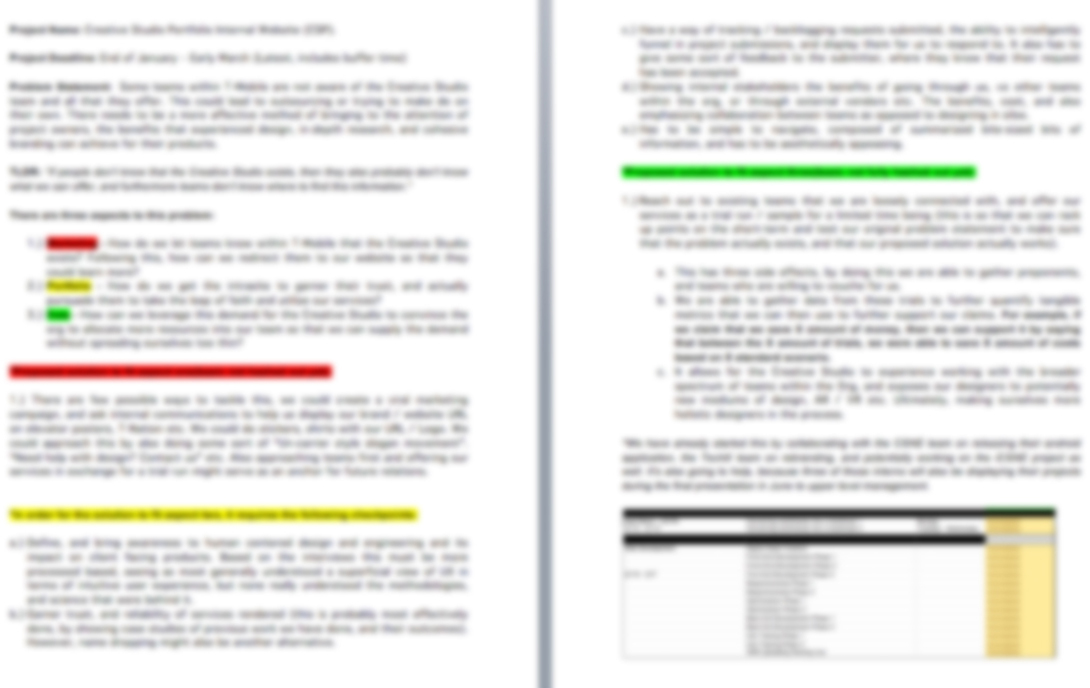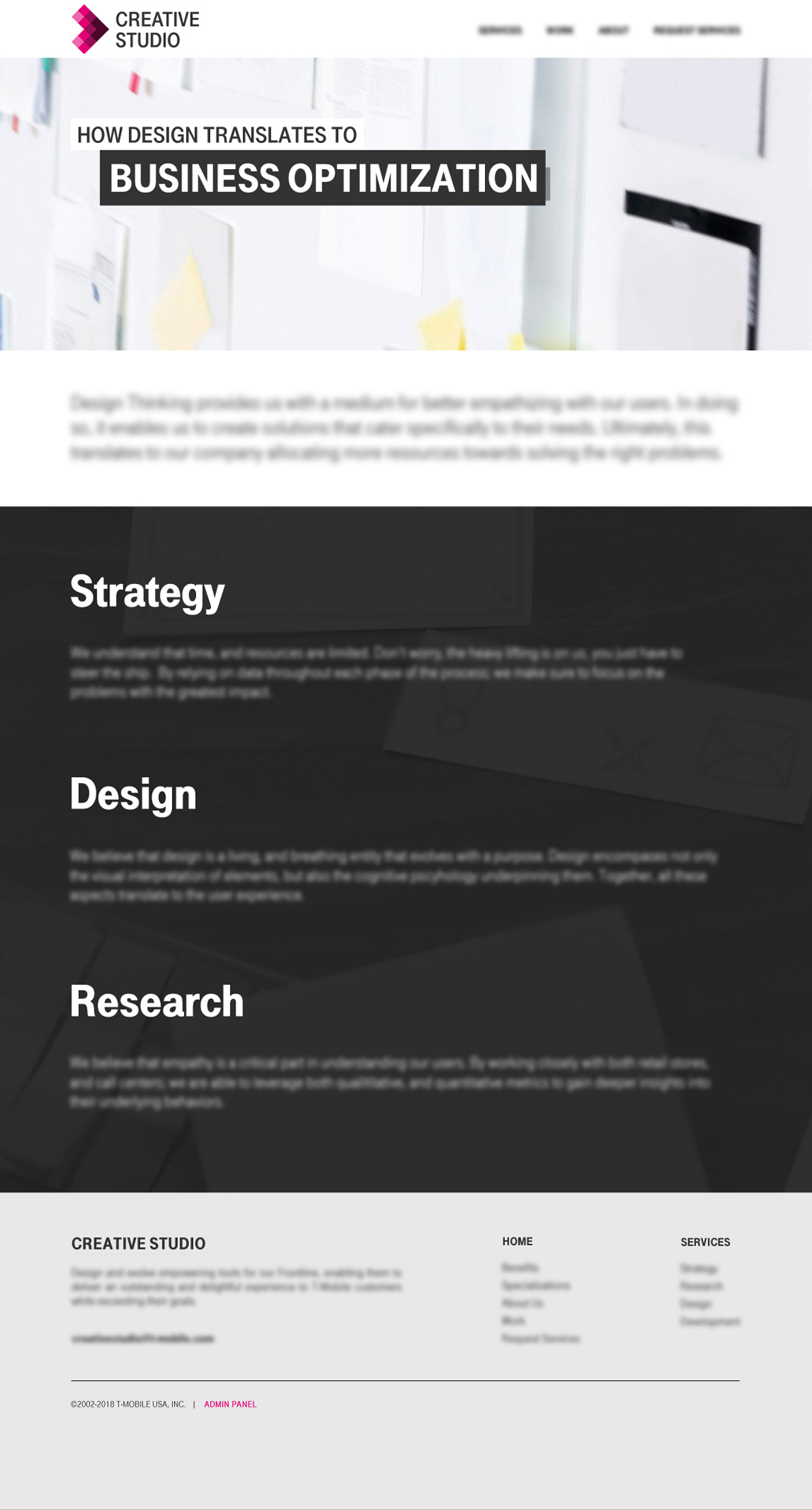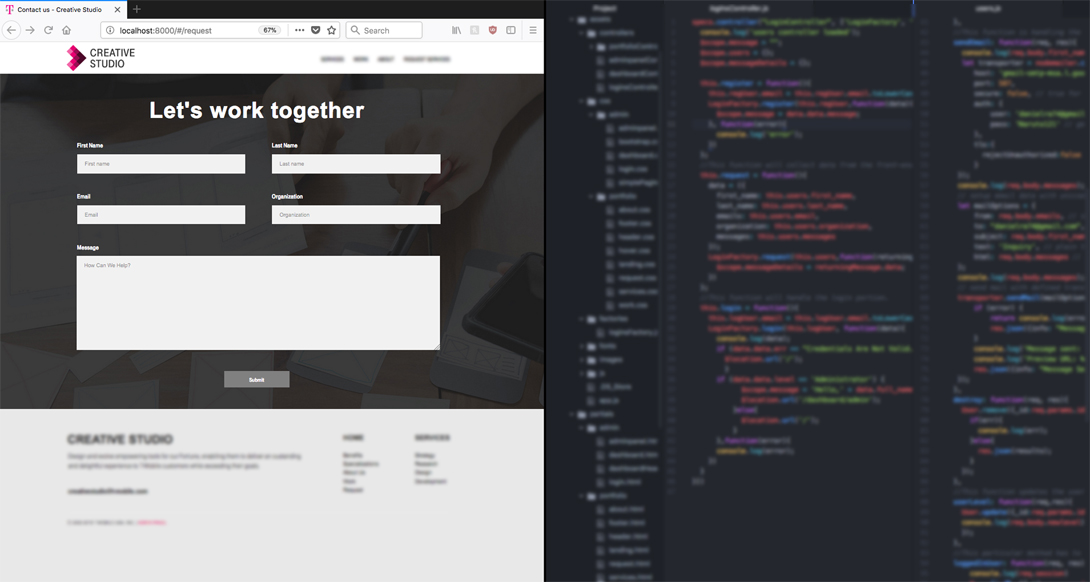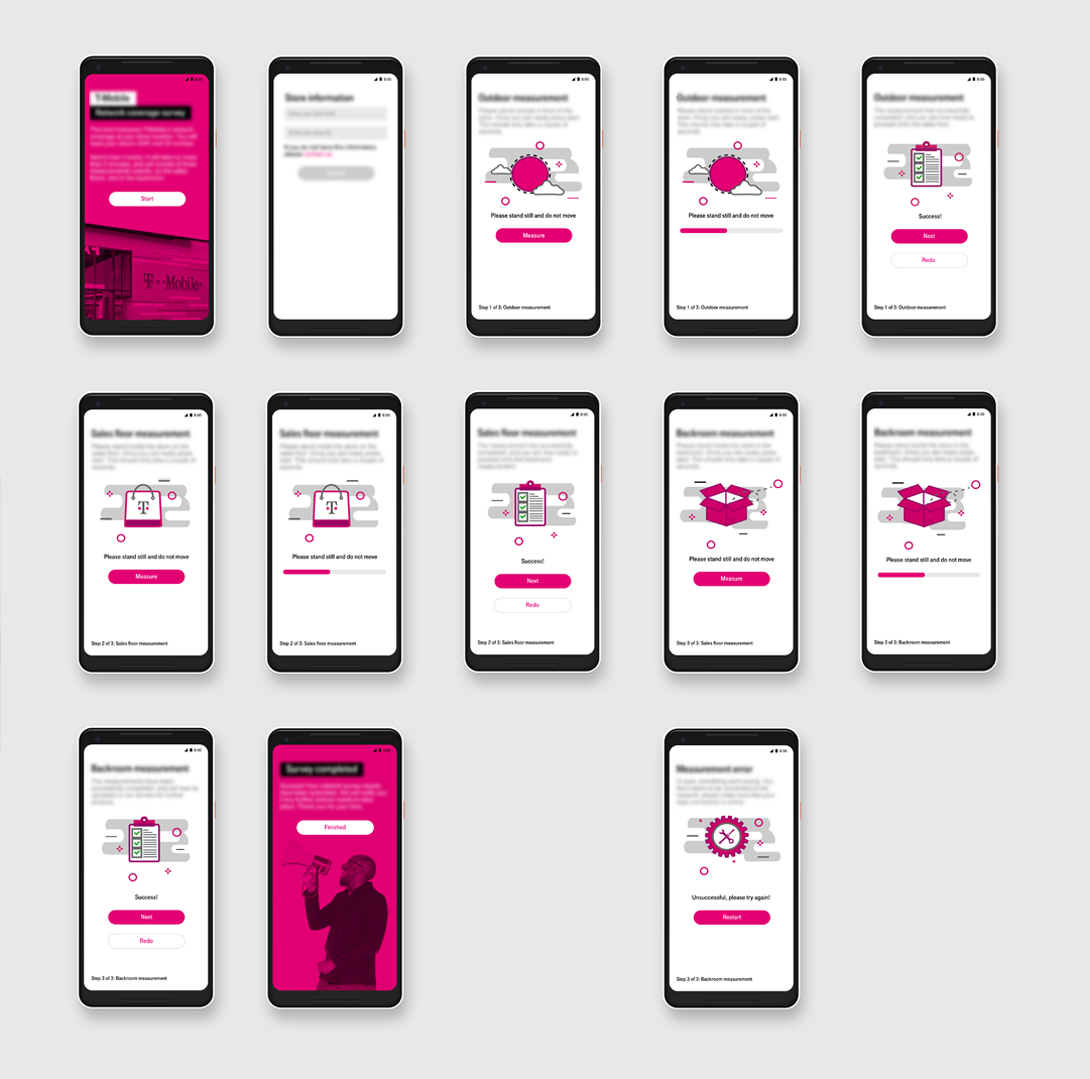Context
In October 2016, and 2017 I took part in a two-year internship program sponsored by T-Mobile. My journey started off as a Software Developer, and transitioned on to the role of a User Experience Engineer. I played vital roles in both the Coverage Strategy, and Network Experience team as well as the Digital Development team.
Role: Throughout the course of the two years I worked on various projects ranging from writing advanced Python libraries to designing, and programming native mobile, and web applications.
*DISCLAIMER Due the sensitive nature of my projects, I cannot forego an in depth review of my internship. However, I can give a bird’s eye overview of some of my major projects.
Creative Studio Portfolio Project
Problem: Some teams within T-Mobile are not aware of the Creative Studio team and all that they offer. This could lead to outsourcing or trying to make do on their own. There needs to be a more affective method for project owners to become aware of the benefits that experienced design, in-depth research, and cohesive branding can achieve for their products.
Solution: Initiate viral marketing campaigns internally to advertise the Creative Studio. Create a platform that connects internal teams within T-Mobile with the Creative Studio / Digital Development Org in order to facilitate additional pipelines of revenue, and save on unecessary costs. Bring awareness to Human Factors Design, and its positive implications on business growth.

[One of the Many Style Guides Used Throughout This Project.]
Guerrilla Research
Sampling Strategy for Collecting Qualitative Data: Since we were limited on time and resources, I opted for a convenience sampling with quota groups. This was, because I knew which focus groups were of interest to my study, and wanted to gauge the relationships between these subgroups, and their characteristics. These subgroups consisted of the creative studio team, project owners, and other independent design teams within T-Mobile.
[Problem Statement,and Survey of Potential Solutions.]

[Qualitative Data Set Coding, and Affinity Diagramming.]

[Broad Persona of Main Target Audience, and Qualitative Interview Transcript.]
Wireframing + Information Architecture

[Initial Paper Ideations.]

[Cross Referencing Grid-Raster Based Systems with Behavioral Psychology.]

[Wireframing Potential Website Layout Solutions.]
High Fidelity Mockups

[Creating Custom Banner Assets, and Illustrations.]

[Landing Page Layout.]

[Services Page Layout.]
Web Development

[Responsive HTML + CSS In AngularJs.]

[Back-end Node Server Email Validation + Intake Form.]

[AWS Elastic Search Via Data Stream From S3.]
The last part of my assignment dealt with hosting and uploading source files onto the cloud. In order to this, I had to establish a Jenkins pipeline that pulled data from a Bit Bucket repository, and initiated a Docker containerization of my Node, and MongoDB components. These containers were then sent off to Artifactory to be pushed into Marathon in order to generate an endpoint to allow for my S3 client (Angular components) to communicate with the back-end.

[Jenkins Pipeline Via Docker + Artifactory + Marathon.]
[Fullstack Web Application Demo.]
CSNE Vendor Android Application UI Integration
The Coverage Strategy, and Network Experience team approached the Creative Studio in regards to a possible collaboration between interns. The project was a vendor application that further automated signal testing for possible store locations. Due to time constraints, our team couldn't implement the standard research protocols, and thus opted to do some minor Guerrilla Research methodologies, as well as UI enhancements following existing style guides.

[Finished Native Android UI + Custom Illustrations.]

[Prototyped Experience.]
TechX Logo Design Contest
T-Mobile's TechX internship program reached out to us to get some branding work done. Our team worked with the project owners to create a logo, as well an illustration for various merchandises. The branding work had to adhere to corporate style guides, which included the use of the Tele-Grotesk font families as well as the iconic Magenta hex values.

[Earlier Ideations.]

[Final Rendition.]
T-Mobile Call Center Support Tool
Problem: Call Center Representatives are having a hard time diagnosing customer complaints with the tools currently at their disposal. Often times, reps have to open up multiple browsers to retrieve fragmented information scattered throughout old legacy software applications.
Solution: Developed a software application that aggregates data from legacy tools into an intuitive, easy to use centralized GUI. This is turn better aided representatives in diagnosing customer complaints in a more timely, and effective manner.

[Customer Care Representative, Bellingham Call Center.]

[Qualitative Interview Notes, and Observations.]

[Software Tool Architecture.]

[Call Center Support Tool.]
Big Data Network Analytics
Problem: As of right now our infrastructure is logging packet loss data by the nanoseconds. This is increasingly inefficient, as it congests our servers with unnecessary amounts of granular data. By zooming in too closely, we tend to miss out on the bigger picture. Ultimately, we would like to understand how this data affects our customer’s network experience.
Solution: Since it’s hard to gain security clearance to pull data from the main servers, I had to mimic the table schematics within MYSQL workbench. I then proceeded to run test queries to appropriately bin large data sets into more insightful time intervals. This output was then separated into states, and run through tableau for visualizations. Following which, I wrote a Python script to logically parse the given data to further categorize these points by distance, and speed using GPS coordinates. This was then imported into Alteryx to create a realistic heat map of failed packet losses throughout any given city.

[SQL Parsing Logic for Binning Large Data Sets, Later Imported Into Tableau for Visualizations.]

[Python Parsing Script, and HeatMapping of Lost Packets Throughout a City.]
CSNE Raspberry Pi Team Dashboard
My next project was a custom dashboard for displaying real-time updates using a Raspberry Pi. Since I didn’t have access to a back-end server, I had to create a lightweight application that was housed directly onto the Raspberry Pi using Electron. The application is automated to be non-programmer friendly, and draws information from a CSV file, that relays Lat / Lon coordinates to Google Maps to display the location of recently created signal towers.

[Main Dashbaord Preview.]
What I Learned
T-Mobile’s Internships allowed me to hone my technical acumen by quite a bit. During my Software Engineering portion, I spent several months within the M.E.A.N (Mongo DB, Express, Angular, Node) software stack, and delved deeply into Python Shell automation as well as web scraping. I also put my statistics background to good use by applying theoretical models to real world scenarios.
On my second time around as a User Experience Engineer, I got the opportunity to really exercise my creativity, and problem-solving capabilities through mediums such as Illustrations, Graphic Design, Interaction Design, and User Research.
All in all, the most valuable takeaway from this was the understanding gained from working in a corporate environment that emphasized strict deadlines, and an agile methodology. I found it infinitely invaluable having the opportunity to immerse myself within the most brilliant minds behind the nations uncarrier movement.

[Letter of Recommendation.]


